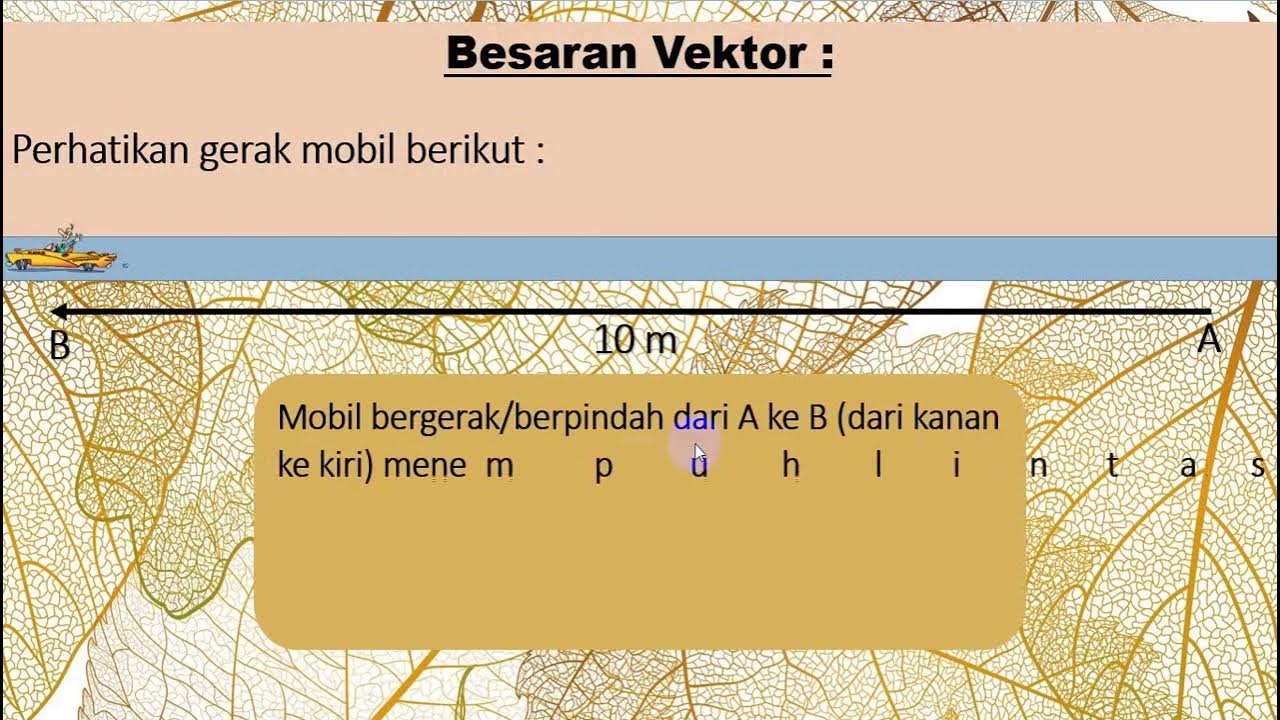FISIKA KELAS X : VEKTOR (PART 1)
Summary
TLDRIn this physics lesson, Yusuf Ahmada introduces vectors, explaining their definition as quantities with both magnitude and direction. He differentiates between vectors and scalars, then covers how to represent and notate vectors using arrows and symbols. The video discusses various methods of vector addition, including the triangle, parallelogram, and polygon methods, demonstrating with examples how to find resultant vectors. The analytical method will be explored in a future video. This educational content is aimed at helping 10th-grade students grasp the fundamentals of vectors in physics.
Takeaways
- 😀 A vector is a quantity that has both magnitude and direction, unlike scalar quantities which only have magnitude.
- 😀 Examples of vector quantities include force, displacement, velocity, acceleration, and momentum.
- 😀 Vectors are represented by arrows, where the direction indicates the vector's direction and the length indicates its magnitude.
- 😀 There are two ways to notate vectors: by using two capital letters with an arrow above or by writing the letter in bold.
- 😀 Vector addition can be performed using several methods, including the triangle method, parallelogram method, polygon method, and analytical method.
- 😀 The triangle method (tip-to-tail method) is used for adding two vectors by joining the tip of one vector to the base of the next.
- 😀 The parallelogram method involves drawing two vectors from the same base and finding the diagonal to represent their sum.
- 😀 The polygon method is an extension of the triangle method and can be used for adding more than two vectors.
- 😀 In the triangle method, to subtract a vector, we reverse its direction before adding it to the other vector.
- 😀 The parallelogram method also applies to vector subtraction, where the direction of the second vector is reversed before adding it to the first.
- 😀 The polygon method can handle more than two vectors, simplifying complex vector additions and subtractions in physics.
Q & A
What is a vector?
-A vector is a quantity that has both magnitude (value) and direction. Examples of vectors include force, displacement, velocity, acceleration, and momentum.
What are scalar quantities?
-Scalar quantities only have magnitude and no direction. Examples include length, mass, area, and volume.
How do you represent a vector graphically?
-A vector is represented by an arrow, where the direction of the arrow shows the vector's direction, and the length of the arrow represents its magnitude.
How can vectors be notated in written form?
-Vectors can be notated in two ways: 1) using two capital letters with an arrow above them (e.g., vector AB), or 2) using a single letter in bold (e.g., vector A).
What is the triangle method of vector addition?
-The triangle method (also called the tip-to-tail method) involves drawing the first vector, then drawing the second vector starting at the tip of the first vector. The resultant vector is drawn from the starting point to the endpoint.
What happens when subtracting vectors using the triangle method?
-When subtracting vectors using the triangle method, the second vector's direction is reversed (negating it). The resultant vector is then determined using the same tip-to-tail method.
How does the parallelogram method of vector addition work?
-In the parallelogram method, both vectors are drawn from the same base, forming a parallelogram. The resultant vector is the diagonal of the parallelogram.
What is the difference between the triangle method and the parallelogram method?
-The triangle method involves drawing vectors tip-to-tail, while the parallelogram method involves drawing both vectors from the same base and forming a parallelogram to find the resultant.
What is the polygon method of vector addition?
-The polygon method is an extension of the triangle method, used for adding more than two vectors. Vectors are added sequentially, with each vector starting from the tip of the previous one.
What is the purpose of the analytical method of vector addition?
-The analytical method involves using mathematical equations to add vectors, breaking them down into components along the x and y axes to find the resultant vector.
Outlines

This section is available to paid users only. Please upgrade to access this part.
Upgrade NowMindmap

This section is available to paid users only. Please upgrade to access this part.
Upgrade NowKeywords

This section is available to paid users only. Please upgrade to access this part.
Upgrade NowHighlights

This section is available to paid users only. Please upgrade to access this part.
Upgrade NowTranscripts

This section is available to paid users only. Please upgrade to access this part.
Upgrade NowBrowse More Related Video

Scalars and Vectors

VEKTOR: PENGERTIAN DAN PENJUMLAHAN - MATERI FISIKA KELAS 10 | Edcent.id

Besaran vektor dan besaran skalar (Fisika SMA/MA Sagufindo kls X smt 1 : Vektor)

Scalars and Vectors | Vector Addition | General Physics 1

Fisika SMA - Vektor (1) - Pengenalan Vektor, Besaran Vektor dan Skalar, Melukis Vektor Satuan (I)

Vektor.
5.0 / 5 (0 votes)